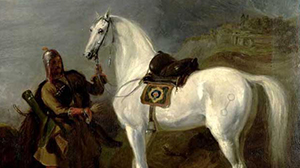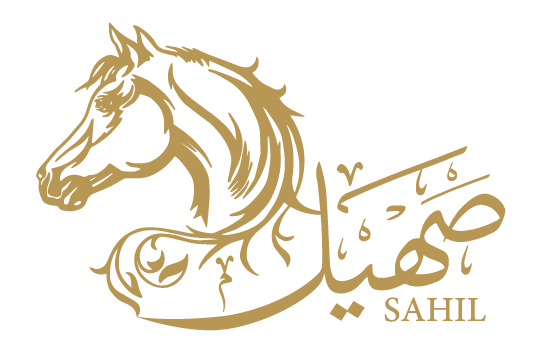Horse during the Mamluk era

The princes of Egypt began to raise Arabian horses in the thirteenth century; they were interested in choosing horses that had beauty, sprinting speed and endurance power, It is mentioned in the book "Mua'eez and Al-aitbaar" by Al-Maqrizi, : That King Al-Nasir Muhammad Ibn Qalawun, the ninth Mamluk sultans, Was passionate about owning Authentic Arabian horses , Especially from the tribes of Al-Muhanna, Al-Fadl and others , Because of his love for horses he was exaggerated in honoring the Arab, even if the prices of their horses exceed the limit, And the tribe of Al-Muhanna came to the Sultan with the best Arabian horses than other Arab tribes , and they were paying Excess prices in them, Until the Arab tribes came to them with their best horses , Al-Muhanna was able to get to the Sultan and reached the highest ranks in his days. the sun of arab al-fadl has shone in the seventeenth and the eighteenth centuries in the days of the mamluk state so they became the arabian kings and the masters of the arabian parari . And when a royal decree was issued from cairo or damascus from the Mamluk king confirming or designating the best sheikh, the decree was to describe this Arab sheikh as "the king of the Arabs" or by "the Sultan of the Arabs" or by " sied Arban al-Bawadi and al-Hadar in al-Sham, Egypt, Iraq, el hegaz , nagd " . one of the most famous el Saqlawiyat horse stables in al-fadl is el-sheikh muhanna bin isa bin muhanna horses' stable ''d. 735 '' , In general al-fadl were famous for owning the arabian Saqlawiyat horses and others. The Sultan did not like horses of the kind "barqh" and if he bought some, he prepared it for distribution and gift to the princes, it was not allowed to gift or distribute horses coming from al-muhanna only for the most cherished princes and close characteristics, and the Sultan knew well the horses and their qualities and genealogy , And still the names of those who brought it to him is mentioned and the price paid, and when he became famous for this, people of Bahrain, Al Ahsa, Qatif and Hijaz brought him the best horses, He paid them from ten to twenty to thirty thousand dirhams for one horse , Including the weight of one thousand five hundred of gold, In addition to what he was enjoying from luxurious clothes and sugar and other appetites, In addition to what he was enjoying from luxurious clothes and sugar and other appetites, there was no tribe of arabs that didn't bring him its best horses and reached the intensity of love Sultan for horses and his desire to pay in one day a price to buy some horses thousand dirhams, and this was repeated more than once that the price of one horse from al-muhanna reached 60 thousand and 70 thousand dirhams, And bought many of the "Persians" eighty thousand and ninety thousand dirhams, He bought the "Bint al-Karashah" for 100,000 dirhams, including five thousand tons of gold, In addition to the royal gifts from villages in Bilad El-Cham, And he was taking care of the horses that he was inspecting them himself, that if a horse was infected or get old he sent it to the pasture, Reproduction occurs between the known Stallions and the parasites at his hands.
Stables' book chronicles the history of delivery and the name of horse and The Persians, and supervised the birth of the sons of horses and the ponies and recorded it in a special record, he had many born horses that made him needn't to buy horses.
Sultan Qallawun built many large stables and great Fields for races, and he assigned a team of skilled Bedouin for them; to train horses and take care of them, and he was holding annual races involving his own horses with princes' horses. It will be remembered that one time a prince from al-Muhanna tribe sent him a grizzled horse and if the prince's horses outrun the sultan's horses then the horses will return to the prince , but if the sultan's horses win then the horses is for the sultan, Only a Bedouin man drives it at the race, The Sultan arrived at The race field as usual with his princes, And Solomon, Moses, and the sons of Muhannah stood with him, The horses were sent from the area of Baraka al-Hajj on its usual basis, and among them was Muhanna's horse, and the Bedouin rode naked without a saddle; Then the other horses followed them until it won the race without a saddle, The Bedouin riding it wearing a shirt and a hat, When he stood in the hands of the Sultan shouted the Bedouin: Happiness for you today, O Muhanna, you will be tired... , and it goes on like these for some time, Then the interest in horses was abandoned after the death of Sultan al-Nasser, where four thousand eight hundred horses died, then the races was abolished after him, and still like that until The beginning of the reign of Sultan Barqouq (King Al-Zaher Saif al-Din) was the first Mamluk Alburgien Egyptians at the end of the third century AD.
And with Sultan Barqouq coming to power the interest in Arabian horses was renewed, Where he tried to follow the steps of Sultan al-Nasser, and he already produced thousands, Where he bought seven thousand heads of horses, but this interest did not last after this Sultan also and the condition of the horses has gone from bad to worse, Until the throne of Egypt was ascended by "Muhammad Ali al-Kabir" at the beginning of the nineteenth century.
Gamal al-Ghitani, in his book, describes the features of Cairo in a thousand years, describing the horses market in the Mamluk era
We head to the sandy square that extends under the mountain castle, Walking around the horse market may have been a natural entry into a welcoming world, Closely related to all the details of life during the Middle Ages, The position of this market has not changed throughout the Middle Ages, The shouts of the auctioneer and the callers rise, Many kinds of horses, But it is divided into three main sections, , Arabian horses, The most expensive and most valuable ones, are required for the race, and catch up, from the countries of the Hijaz, Najd, Yemen, Sham, Iraq, Egypt, barqa. The second type, Turkish or Ajami, called Hamalij, or Akadish, is desirable for its patience to walk Strenuously, And the speed of walking, the third type is born between Arabic and Ajami, if the father is Ajami and an Arab mother, it is said be a hybrid, And the speed of walking, the third type is born between Arabic and Ajami, if the father is Ajami and an Arab mother ,it is said be a hybrid, It is the middle of the former species, and the foreign horses are the most unsuccessful species, and cheaper here, and no one accept them.
The Mamluk system has two pillars, the knight, and the horse, Perhaps this was a strong reason for the importance of the horse market, And its closeness to the castle of the mountain, the center of government, and the symbol of power in Egypt at that time, in the market we see many colors of horses, But the four basic colors, and other than that ramified, The first is the white color, and the Mamluk Sultans preferred it, and called it the Persians Bouz. Ibn Iyas states in the "Bada'i al-Zuhour" that the Sultan of Ghuri, when he took off to Karkad the Ottoman Beck gave him a Booz horse with a golden saddle and a Knebosh, and does not mention the departure of the Sultan Ghuri in the processions, without a large white booz horse, The second: is black, and every very black horse was called "Adham''. And the third is the red color, called Kumait, The fourth color: is yellow and knowing colors of horses are necessary for knights, commanders and military units, And sometimes some of the knights are keen to ride a horse with a certain color every day, It was customary to ride the Adham any black on Saturday, And Sunday for the white, And Monday for the green, And Tuesday to Kumait, And Wednesday to Obelka, which was among the white, On Thursday for the blonde and on Fridays for the Mahgl, and these colors have a relationship to optimism, Not limited on optimism and pessimism only on the general color of the horse, but it is about some signs in his body, The blaze which is whiteness in the face of the horse, if it was circular or was similar to the letter H, it shows luck and the blessing, And if the whiteness hit one cheek without the other, the Persians be hated, and it became croak, and also if one eye was covered without the other it would be expected to be killed with its owner, if its eyes was covered then it would be defeated with its knight, If it was tilted to the right indicates the pessimism, and if tilted to the left it means gainings, If it reach the nose, it indicates blessing and good, and if there was a different color in the horse's leg from its body that was hated, And in the year 802 AH - 1399 AD, the prince tnm was broken and fell captive, The historian Ibn Taghri Bardi asked about the reason for the Prince's fall from his horse, Then captured. And they said: that his horse was bad luck, And referred to this relation, And said: that his companions warned him about riding it but he refused.

Comments/ 0